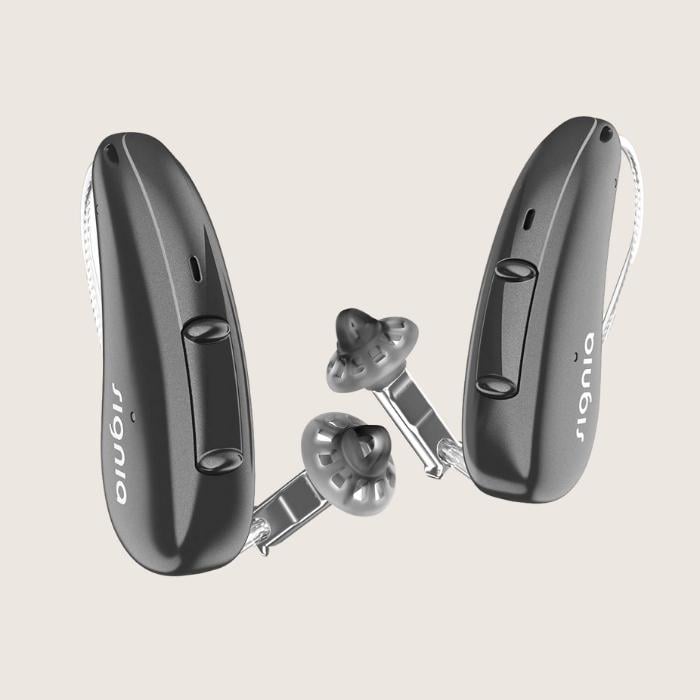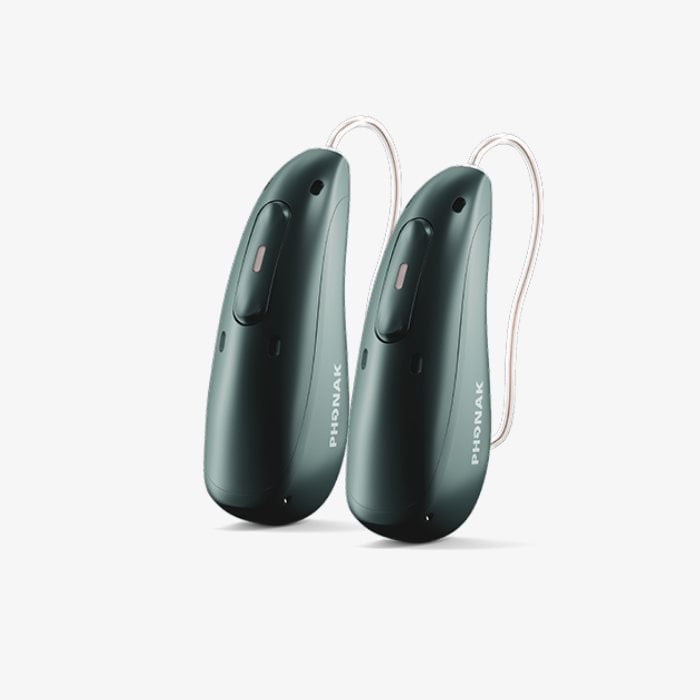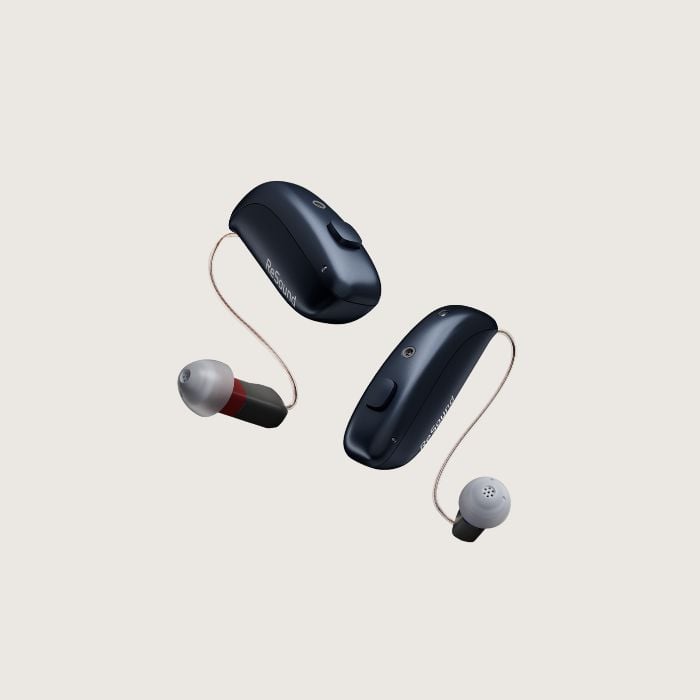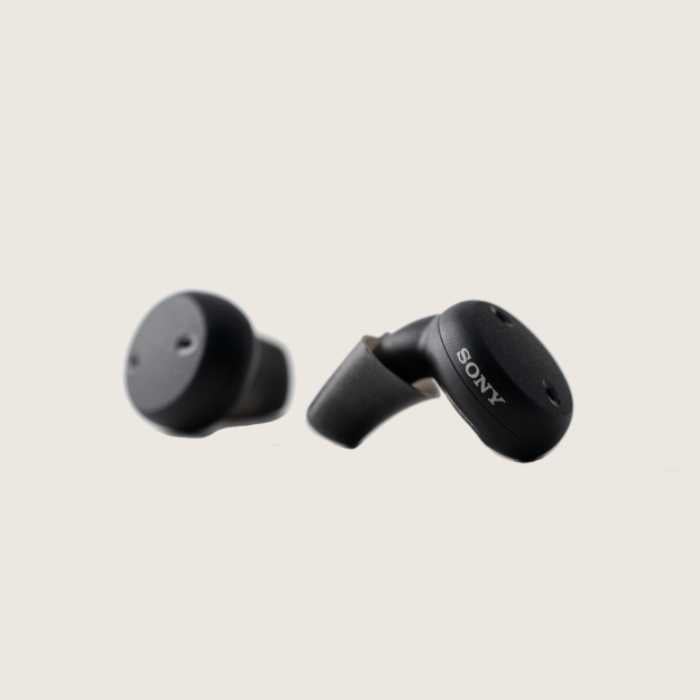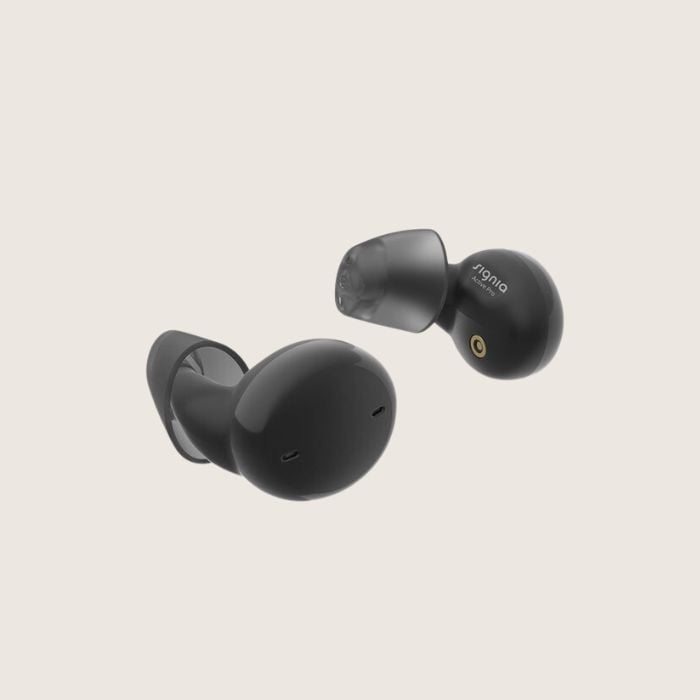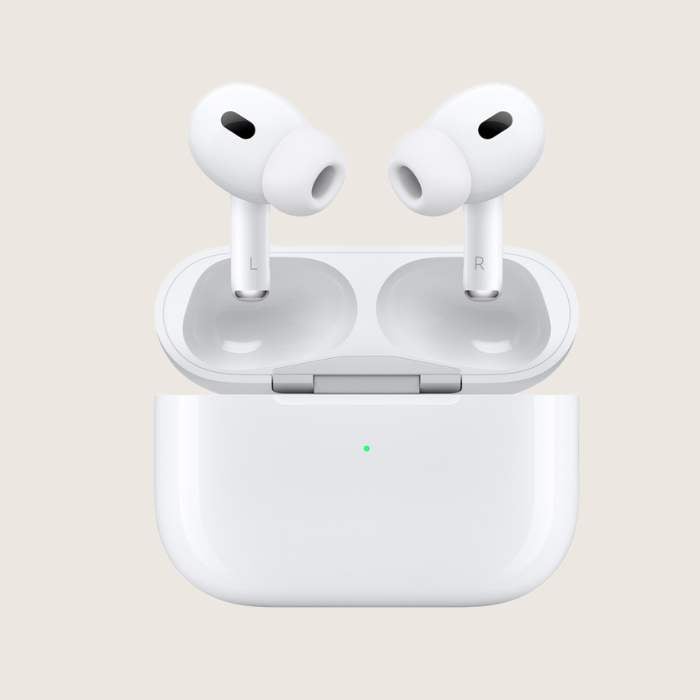A Brief Bluetooth Hearing Aid History
In 1994 Jaap Haartsen and his colleagues set out to connect two nearby devices without a cord. It seems simple now, but they had no idea how to make it work.
Eventually, they devised a plan to send low-power electrical signals through the air using what they initially called "short link" radio.
They later named the technology Bluetooth and published a protocol that turned the invention into a global standard.

Over the next several years, Bluetooth spread to phones, headphones, and radios. In 2004 Starkey released the first Bluetooth hearing aid using a clunky design plugged into the bottom of a hearing device.
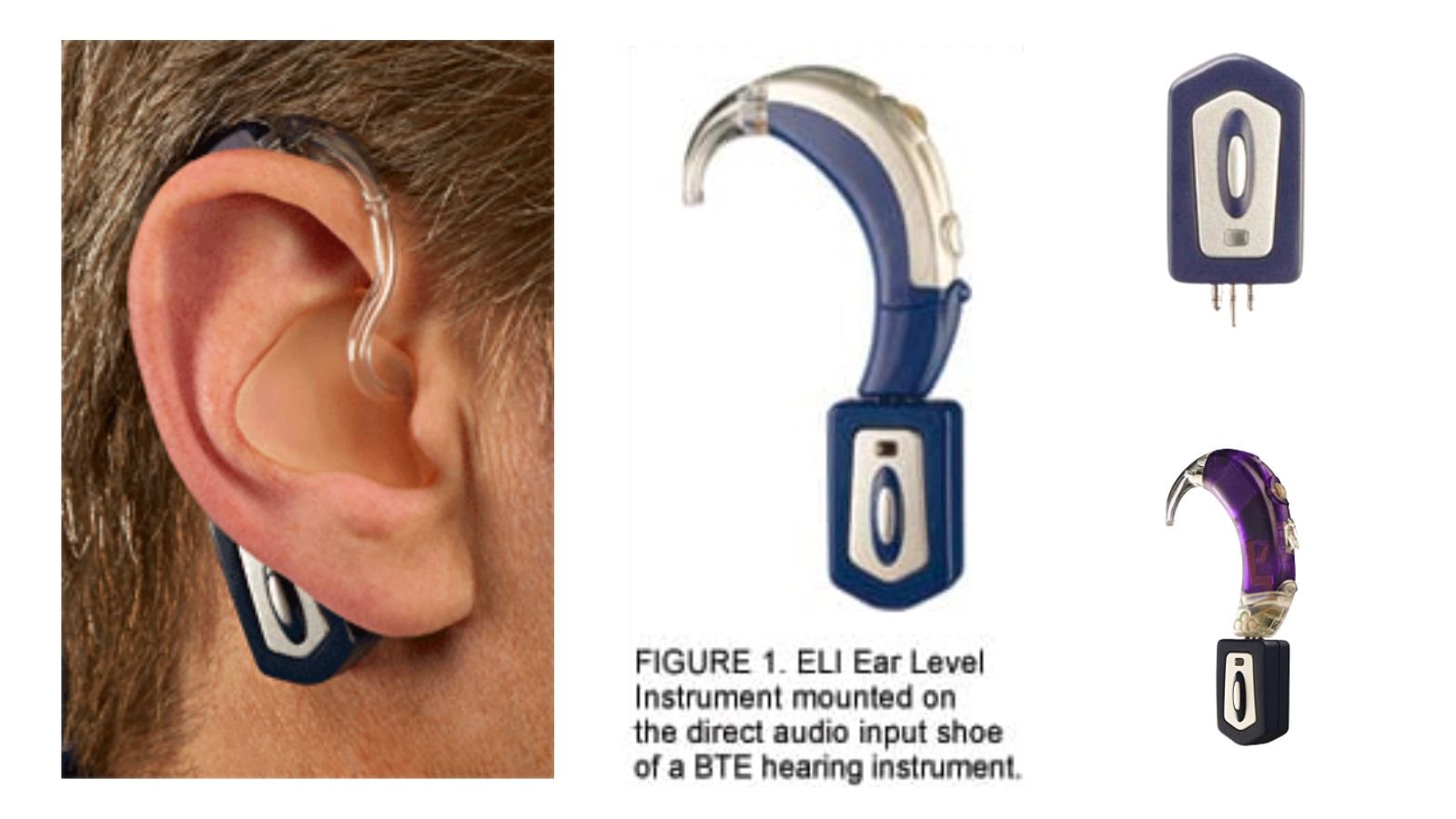
Bluetooth hearing aids have come a long way in the 21 years since they were first released.
Today there are dozens of powerful Bluetooth-enabled hearing devices on the market. Bluetooth connection allows for conveniences for hearing aid wearers like:
- Listening to podcasts and music directly through your hearing aids
- Connection to a hearing aid app that can control settings and volume + indicate when your battery is low
- Take phone calls without holding the phone to your ear
- Some hearing aids are using Bluetooth to experiment with fitness tracking, fall detection, and language translation
Someone buy Jaap a drink. 🍺
How did we choose the Bluetooth hearing aids below?

Our team personally tested each of the Bluetooth hearing aids listed below. These are some of the factors we considered.
- Phone and device compatibility. We tested products for phone compatibility. In general, leading Bluetooth phones can stream from both Android and iPhone but they are only enabled for two-way phone calls (picks up your voice) for iPhone. Sennheiser All Day Clear and Phonak Infinio are two notable exceptions. If you use an Android device you'll want to consider one of those two options.
- Consistent connection. We also looked for devices that hold a steady connection with your phone as you move around your home or life.
- We looked for outliers—like the Sony CRE-E10, a unique earbud and hearing aid crossover.
- We also looked for variety. Everyone has different needs and preferences. We looked for hearing aids with a variety of price points and form factors.
Prefer to watch?
See our latest video review of the best hearing aids with Bluetooth on the market below. 👇
Here are the best Bluetooth hearing aids for 2026. 👇
- 50+ hearing aid brands reviewed and rated by our team of hearing aid wearers and audiologists
- 200+ hours each month spent researching brands and care options
- 2,000,000 people shopped on Soundly in 2024
- 100% independently owned and operated
Read more about our company, services and process here.
Featured in this article
Best Overall OTC - Sennheiser All Day Clear
Sennheiser All Day Clear is made by the same manufacturers behind Phonak and Unitron - Sonova. This affordable, self-fitting hearing aid is our top choice for the best value among OTC hearing aids.
Sennheiser All Day Clear connects to both iPhones and Androids seamlessly via Bluetooth Classic, offering hands-free calls on either phone type and positioning it among the most affordable Bluetooth hearing aids with simplified connectivity.
Sennheiser All Day Clear
- Our favorite OTC hearing aids for under $1,000
- Manufactured by the largest hearing aid maker in the world
- Compatible with iPhone and Android devices
Sennheiser All Day Clear is our top-selling and best-rated OTC hearing aid at Soundly.com. We’ve tested this product extensively—in the audiology test box, in real-world noisy environments, and through thousands of Soundly customer experiences in 2025.
Soundly offers a complimentary setup call with every purchase — a helpful perk for customers and a valuable way for us to hear firsthand which products are performing best.
At-Home Delivery

Sennheiser All Day Clear is made by Sonova, the world’s leading hearing aid manufacturer. Unlike traditional in-clinic devices that average around $5,000 a pair, All Day Clear ships directly to your home (Soundly offers free 2-day shipping) and lists for $999 per pair.
Rechargeable with Bluetooth
These hearing aids deliver 18–20 hours of battery life on a single charge and offer reliable call and music streaming for both iPhone and Android users. Thanks to Sonova’s Bluetooth Classic connection, pairing is easier than most OTC devices—especially for Android users.
App Programming

As a self-fitting product, All Day Clear uses a smartphone app to adjust the hearing aids to your specific hearing loss. The app isn’t the most feature-rich on the market, but in our testing (and from what we hear from customers), it’s the easiest to set up and navigate.
Sound Quality
Likely your biggest question: how do they sound? In short—excellent. You can hear Sonova’s signature processing in these devices. They handle sudden sounds, wind, feedback, and background noise in a way we’d consider market-leading for OTC self-fitting hearing aids.
Notes & Watchouts
- Best suited for mild-to-moderate hearing loss. If your loss is more significant or complex, in-clinic care is still the right move. Take our hearing test to better understand your loss.
- The charger must be plugged into the wall while in use. A separate power pack is available if you want mobile charging.
Bottom line: Sennheiser All Day Clear sits at the top of our list for self-fitting OTC hearing aids. It delivers great sound, simple control, and strong value from a world-class manufacturer.
You can purchase Sennheiser All Day Clear hearing aids directly through Soundly for $999 per pair and access all of our care and services.
We recommend taking our hearing test before purchasing. Our team can review your results and offer a second opinion if needed.
Once you’re ready, you can place your order on the website or over the phone.
- Sennheiser orders come with 100-day risk-free returns — exclusively on Soundly.
- Your hearing aids ship 2nd Day Air to your home.
- Upon arrival, you’ll receive setup instructions and use the smartphone app to customize your hearing aids.
- Sennheiser includes starter domes in the box; you can purchase alternate sizes and styles through Soundly.
- Every order includes a complimentary setup session with one of our hearing professionals.
- We offer MSRP pricing and deals and will price-match any other official retailer offering the same product and terms.
- Soundly provides 45-day price-drop protection—if the price drops within 45 days, contact us and we’ll refund the difference.
Here's what Dr. Amy Sarow, Audiology Lead at Soundly, had to say about the Sennheiser All Day Clear:
What is your experience supporting customers directly with this product. What comes up a lot?
Customers often ask about how to adjust their devices to match or closely align with their audiogram. While OTC devices use ‘presets’ - if they have a mild to moderate high frequency loss, we can usually come close to what is appropriate for their needs.
The Sound Profile uses three categories during the setup: volume, clarity, and balance. We generally perceive volume in the low frequencies, most people have normal hearing to mild hearing loss in that region, so the preset default of 3 is usually fine.
The clarity setting is the amount of high frequency amplification. The default here is also 3, which is appropriate for a mild loss and for a moderate loss a high number is more appropriate (i.e., a 5 or 6). The balance setting allows the user to adjust volume for right and left separately.
Customers often ask how to keep the adjustments when they ‘split’ the volume on the main app screen, but this setting will revert back to the middle after the hearing aids are placed in the charger and taken out again the next day.
Compared with other hearing aids at a similar price, where does Sennheiser All Day Clear stand out, and where does it fall short?
Compared to other products at the same price point, Sennheiser All Day Clear shares the processing of its prescription counterparts (Unitron and Phonak).
The sound processing feels smoother and more sophisticated than some other options in this pricepoint or lower.
The ADC also does an excellent job of feedback suppression, with some other similar OTC products more prone to feedback in the ear.
However, the ADC app falls a bit short compared to some of the other OTC apps. For example, no direct controls in the app for background noise suppression, ability to directly select hearing aid programs.
The app feels a bit more simplistic than some comparable OTC brand apps.
Who is this product best for?
This product is best for those who have mild to moderate hearing loss and works particularly well for a sloping hearing loss configuration.
For those with normal hearing in the low frequencies, they may experience some static or white noise sound, but this can be reduced by adjusting the ‘mid’ category down on the equalizer.
Additionally, this product works well for those who like to stream audio via Bluetooth, works better than other products for those who like to listen to music, and is a great option for those who prefer an app that keeps things simple.
It’s not always the best choice for glasses wearers (though still possible) or those with very petite ears.
- Premium Sonova-built technology for less than prescription channels
- Bluetooth streaming and hands-free calls (Android and iPhone)
- Comfortable all-day form factor
- Charger must be plugged in while charging
- Requires a smartphone for programming
- All-Day Clear is an OTC product appropriate for mild-moderate hearing loss levels
- If you have more significant hearing loss you might consider local or Telehealth care. Read more about prescription Vs. OTC hearing aids here
- Available for purchase online via Soundly
- Does not require a prescription from a doctor
- Customize your hearing aids with the Sennheiser All-Day Clear app
- Soundly customers get a complimentary guided setup session
- Sennheiser offers impressive underlying background noise management technology
- We found this product performed at a similar level to top prescription brands
- Comfortable receiver-in-canal style is great for all day wear
- Sits behind the ear with a receiver (speaker) that reaches into the ear canal
- The form factor of Sennheiser All-Day Clear is comparable to leading prescription hearing aids like Phonak Lumity
- Available in a dual-tone black and silver
- Choose between slim and non-slim versions (we recommend the non-slim option for most people)
- Sennheiser All-Day Clear comes with rechargeable batteries
- 16 hours of wear on a single charge
- Recharge case must be plugged into the wall while in use
- All-Day Clear streams to all devices including iPhone and Android
- All Day Clear allows hands free phone calls on both iPhone and Android
- Streaming quality is similar to the top prescription products on the market
- All-Day Clear is reasonably easy to handle but does require the wearer to place the hearing aid behind their ear and insert the receiver into the ear (consistent across all behind-the-ear styles)
- The All-Day Clear recharge case has ports that must be in contact for charging. This type of charger is more difficult than premium conduction chargers which do not require ports to be touching
- Sennheiser All-Day Clear hearing aids have an IP68 rating
- These devices can be submerged in up to one meter of water for 30 minutes without damage
- The Sennheiser All-Day Clear app enables setup and customization of your hearing aids
- The smartphone app allows on-the-go volume and sound quality adjustments
- The All-Day Clear app has a music and automatic program but does not offer Tinnitus masking, program creation or other advanced features
In-Clinic Leaders - Signia, ReSound & Phonak
Nearly all receiver-in-canal hearing aids at local clinics are Bluetooth-enabled. That list includes Signia, Oticon, Widex, Phonak, ReSound and more. As of early 2024, three brands stand out from the pack on the Bluetooth front - Signia, ReSound and Phonak.
- Signia offers a well-rounded Bluetooth experience with Bluetooth Classic connectivity for both iPhone and Android devices.
- Phonak also uses Bluetooth Classic and supports connection with up to four devices simultaneously.
- ReSound stands out by incorporating the latest Bluetooth Low Energy features, including Auracast. ReSound's Vivia hearing aids include Auracast controls in the app—an industry-leading feature.
Signia Charge&Go
- Excellent all-around sound processing—one of our top picks
- 39-hour battery life on a single charge
- Compact design: one of the smallest receiver-in-canal (RIC) devices available
- Custom-programmed by an audiologist at your local clinic
Signia Charge&Go is a standout for those seeking a well-rounded prescription hearing aid that combines advanced features, sleek design, and extended battery life. Here’s why we love it:
- Long Battery Life: With up to 39 hours of power (34 hours with streaming), it’s perfect for reliable, all-day use without constant recharging.
- Speech Clarity: Multi-beamforming technology sharpens speech even in noisy environments, helping users focus on conversations with ease.
- Advanced Features: Includes Own Voice Processing (OVP) and Bluetooth LE Audio for smooth streaming from both iOS and Android devices, enhancing audio quality.
- Comprehensive App Support: The Signia smartphone app offers fitness tracking, remote care (after the first appointment), and Signia Assistant, adding customization and convenience.
Customer reviews for Signia Pure Charge&Go are generally positive with nearly all customers celebrating crisp and clear sound. Some customers even report improvements in tinnitus using Signia's in-app tinnitus features. Like all hearing aids, some users find that adjustment to hearing more sound is a process. See more reviews from our partners at ZipHearing.
- "I can hear again!! No more asking people to repeat what they said, turn up the TV, or be staring blankly because I wasn't sure someone was addressing me. I can hear the water that I accidentally left running outside (old pipes in an old house). It's wonderful!!" - Mary
- "I LOVE my new Signia Pure Chareg&Go 5 IX hearing aids. I'm 81 and these are my first so I wondered if I'd have trouble adjusting to the sound or the aids. The answer is neither! The sound is very natural - I'm now hearing highs I haven't heard for decades. From the first day I've been wearing them for 16 hours per day and don't even know they're there." - Jeff
- "The sound quality is very good .Ive had chronic tinnitus for over a year and three months. I use ocean sounds for my therapy , it sounds like you are there. They are discrete and easy to wear . I have reduced my tinnitus by 65 to 70 percent In just about 3 months. Take the step , put in the time and results will follow." - Harly
- "Sound quality is very tinny but from what I've read, that is to be expected. I know my family and friends are happy to not be repeating themselves over and over again. It's very hard to review a product when you have nothing to compare it to." - Colleen
- Among the smallest body size on the market
- Second longest battery with 39 hours per charge
- Excellent in background noise
- Fully customizable with premium sound processing
- Only sold through local clinics at $3,198 - $7,000 a pair
- Does not include a Find My Hearing Aids feature
- Signia Pure Charge&Go is a fully customizable, prescription hearing aid appropriate for mild-severe hearing loss
- If you have severe hearing loss, your care provider may fit you with a custom earmold to reduce feedback
- If you have profound hearing loss, you may be a better fit for a high-powered BTE style hearing aid
- Signia Pure Charge&Go is a prescription device fit and programmed by a professional
- After an initial fitting, you can connect with your care provider remotely through the Signia app
- Signia uses a unique Split Processing technique helps isolate background noise and boost speech clarity
- Signia's Own Voice Processing (OVP) helps take the edge off of that uncomfortable sound quality of the user's own voice that many patients experience when adjusting to hearing aids
- Signia Pure Charge&Go comes in in a small and comfortable receiver-in-canal style that is easy to wear all day
- We prefer Signia's dome tips to other brands for comfort and performance
- Sits behind the ear with a receiver (speaker) that reaches into the ear canal
- Signia Pure Charge&Go is one of the smallest receiver-in-canal hearing aids on the market
- Choose between ten color schemes including: Black, Graphite, Dark Champagne, Silver, Pearl White, Fine Gold, Deep Brown, Sandy Brown, Rose Gold and Beige
- Choose between disposable and rechargeable batteries
- 36+ hours on a full charge
- Popular charger options: Portable charger with induction charging, or plugin Dry & Clean charger
- Signia Pure Charge&Go BCT IX uses Bluetooth Classic to connect with a wide variety of phones and devices
- Signia upgraded their connection strategy in 2025 and is now among the most connected hearing aids in the industry
- Signia Pure Charge&Go is reasonably easy to handle but does require the wearer to place the hearing aid behind their ear and insert the receiver into the ear (consistent across all behind-the-ear styles)
- Signia Pure Charge&Go uses a pin charger with magnets that makes daily charging fairly easy
- Signia Pure Charge&Go is water resistant with an IP rating of 68
- This hearing aid can withstand dust and water submersion in one meter of water for up to 30 minutes
- Signia Assistant: Built in app feature that uses natural language to prompt changes
- Remote care: Included in the Signia app (not a separate app)
- Customization: Treble/bass, volume, microphone directionality, Signia Assistant
- Tinnitus masking: Customizable options through your hearing care professional
- Find my hearing aid: Not available
- Health tracking: Step tracking, activity (e.g., high intensity versus low), and wear time
Phonak Sphere Infinio
- Flagship device from the world’s top hearing aid manufacturer
- Industry-leading onboard AI processing with advanced Spheric mode for enhanced clarity
- Best-in-class Bluetooth streaming, compatible with both Android and iPhone
Phonak’s Infinio and Infinio Sphere models, released in mid-2024, quickly caught industry attention with groundbreaking features:
- Real-Time AI Processing: Phonak leads in AI innovation with its dual-chip architecture, powering real-time adjustments that make listening easier in complex, dynamic environments. This level of AI-driven sound processing sets Infinio Sphere apart as a top choice for clarity and adaptability.
- Extended Bluetooth Range: Enjoy hands-free streaming and calls with 2x the Bluetooth range, making Phonak an ideal pick for both iOS and Android users who value reliable connectivity.
- Waterproof and Durable Design: Built with an IP68 rating, Infinio Sphere withstands water exposure and daily wear, appealing to users with active lifestyles who want durability alongside performance.
Phonak’s Infinio line combines onboard AI with practical, user-focused features, making it an excellent choice for those seeking top-of-the-line performance and versatility in hearing aids.
Phonak Infinio Sphere receives highly positive reviews, with many users noting significant improvements over previous Phonak models and competing brands. Wearers praise its sound quality and robust Bluetooth streaming. The main complaints we found relate to the larger size and occasional automatic mode switching. Some highlights from our partners at ZipHearing.
- "Wearing these new Phonak Sphere Hearing Aids has been very comfortable and an easy adjustment for me. These are my first hearing aids and the sound with them on sounds very natural. I've been able to understand my friends in a crowded restaurant and have been able to turn off the closed captioning on my TV. The Bluetooth feature has worked well for both streaming music and phone calls. I haven't found any drawbacks yet!" - Eileen
- "I have been wearing hearing aids for 6 years. I started my journey with ReSound which lasted nearly 5 years. I then went to Costco and discovered Costco aids are fine for people with modest hearing loss, but I needed more. I then went with Phonak Sphere and have been very happy. I am active and discovered early on the aids I had purchased were being negatively impacted by sweat. Phonak replaced them with water resistant aids for a very small charge. I am very pleased with my new aids." - David
- "Sound quality is excellent. Definitely an improvement over previous HA. Still trying it out in noisy environments but I definitely see an improvement when in noisy situations in understanding speech." - Ken
- "I am currently wearing the Phonak Audio Sphere 90 hearing aids. Had them about two weeks now and the sound quality is very good. I am a bit frustrated with the Automatic program selection as it does not really seem to pick the correct program for the situation. I have not noted the sphere function working as of yet, even though I have been in a few very noisy situations. They are comfortable and only took a few days to adapt to the thicker design of the body. The battery life is exceptional. After wearing them for 15 to 16 hours they still have 45 percent batter life. The only other complaint is the charger case. It is not easy to get they in and almost kink the wires to the domes. I wish they were bigger like my previous Marvels." - Brian
- Top of the line sound processing (thanks in part to onboard AI)
- Best-in-class Bluetooth connection
- Highly water-resistant option available for active lifestyles
- Sphere is a premium product with an average price of $4,598 per pair.
- Shorter than average battery life of 16 hours per charge
- Phonak Sphere is larger than most hearing aids on the market (due to a larger battery and two onboard chips)
- Phonak Infinio is a fully customizable, prescription hearing aid appropriate for mild-severe hearing loss
- If you have severe hearing loss, your care provider may fit you with a custom earmold to reduce feedback
- If you have profound hearing loss, you may be a better fit for Phonak's high-powered Naída Paradise
- Phonak Infinio is a prescription device fit and programmed by a professional
- After an initial fitting, you can connect with your care provider remotely through the myPhonak app
- Phonak is one of our top reviewed products for background noise management
- Phonak Sphere Infinio uses a first-to-market onboard AI processing chip which makes up to 7 million adjustments per second
- Phonak Infinio comes in in a comfortable receiver-in-canal style that is easy to wear all day
- Sits behind the ear with a receiver (speaker) that reaches into the ear canal
- Phonak Infinio offers a rounded, modern form factor and a comparable size to other leading devices
- Choose from a variety of colors including: Chestnut, sandalwood, sand beige, silver gray, graphite gray, velvet black, beige, champagne
- Phonak Infinio comes with rechargeable batteries only
- 24 hours on a 3-hour charge (including 80 min of streaming); 30 minute quick charge provides 6 hours battery life
- Standard charger uses inductive charging
- Phonak Infinio is among our top choices for Bluetooth capabilities
- Allows simultaneous connection to up to four devices
- Allows hands-free calling for both iPhone and Android devices
- Users can tap their hearing aid to answer calls
- Telecoil is available
- Infinio uses universal connectivity for all Bluetooth devices (other leaders use MFI and ASHA)
- Infinio offers 2X the Bluetooth range (distance from your device) compared to older models
- Phonak Infinio is reasonably easy to handle but does require the wearer to place the hearing aid behind their ear and insert the receiver into the ear (consistent across all behind-the-ear styles)
- Infinio devices come with an onboard toggle switch for volume and program changes
- Phonak Infinio is water resistant with an IP rating of 68
- Infinio has even stronger waterproofing than previous models from the brand
- This hearing aid can withstand dust and water submersion in one meter of water for up to 30 minutes
- Remote care: Available through the Phonak app in coordination with your provider
- Customization: Volume, treble/bass, adjustable custom programs in the app
- Tinnitus masking: Available through your healthcare provider
- Find my hearing aid: N/A
- Health tracking: Tracks length of wear time and step count
ReSound Vivia
- ReSound Vivia is a market leader in AI-powered sound processing
- Vivia is one of the smallest RIC hearing aids available
- Auracast-enabled for seamless Bluetooth streaming, developed in collaboration with Bluetooth SIG
- Impressive 20-30 hour battery life on a single charge - even with AI features enabled
- Custom prescription programming provided by a local audiologist
ReSound Vivia is ReSound’s most advanced prescription hearing aid yet—engineered for natural sound, effortless streaming, and top-tier comfort. Here’s what makes it stand out:
- AI-Sound Processing: Vivia features ReSound’s newest 6th-generation chip and a new AI-powered sound management system that helps in loud environments like restaurants or group conversations. Vivia also supports Auracast for future-ready audio streaming in public spaces.
- Design Notes: Vivia is one of the smallest RICs on the market and sits comfortably behind the ear—comfortable even for glasses wearers. It comes in several colors to match hair or skin tone and is built to withstand sweat and water (IP68-rated).
- All-Day Battery Life: Rechargeable models offer up to 30 hours on a single charge and come with a convienient portable charging case. This length of battery life is impressive given the powerful new AI features onboard.
If you’re looking for a small, high-performance hearing aid with cutting-edge AI features, ReSound Vivia is one of the best available today.
Read more reviews via our partners at ZipHearing.
- Noticeable Improvement Over Previous Devices
Many customers say Vivia is a significant upgrade from earlier ReSound models like the Linx Quattro or older analog hearing aids. - Exceptional Sound Clarity
Multiple reviewers highlight Vivia’s ability to deliver natural, nuanced sound and make conversations easier to understand—even in noisy environments. - Great for First-Time or Returning Users
Some users returned to ReSound after years away and found the Vivia to be intuitive, effective, and worth the switch. - Comfortable and Discreet
Wearers appreciate the small size, subtle design, and comfortable fit—even with glasses. - Mixed Feedback on Music and Sound Environments
One reviewer noted that music listening and sound handling in restaurants were still challenging, though they acknowledged the technology may be better suited for different types of hearing loss.
- Great for background noise management
- Auracast compatible
- Small form factor and an optional 3rd microphone in the ear
- 30-hours of battery life
- More expensive compared to direct to consumer and OTC options
- Vivia's in-ear M&RIE microphone is a bit larger and can be uncomfortable for some
- ReSound Vivia is a fully customizable, prescription hearing aid appropriate for mild-severe hearing loss
- If you have severe hearing loss, your care provider may fit you with a custom earmold to reduce feedback
- If you have profound hearing loss, you may be a better fit for ReSound high-powered BTE
- ReSound Vivia is a prescription device fit and programmed by a professional
- After an initial fitting, you can connect with your care provider remotely through the ReSound app
- ReSound Vivia is an excellent choice for background noise management. The new onboard AI chip is focused on increasing clarity in the toughest listening settings
- Vivia uses a combination of beam forming microphones and noise reduction algorithms to single out speech in complex noise environments
- ReSound Vivia is a discreet and comfortable product, but some users with smaller ear canals find the M&RIE receiver uncomfortable in their ears. M&RIE can be removed by your care provider and replaced with a standard receiver.
- ReSound Vivia hearing aids sit behind the ear
- Vivia is one of the smallest behind-the-ear style devices on the market. Vivia's size is particularly impressive given the new dual-chip architecture and strong battery life.
- Vivia comes in a wide range of colors, including new Navy Blue and Red options.
- Vivia comes with three battery options, including micro RIE rechargeable (30 hours), a larger disposable battery version (size 13), and a second disposable battery option (size 312).
- A rechargeable version of Vivia is also available with a CROS (for single-sided deafness)
- Vivia is one of the first hearing aids on the market to release Auracast-compatible hearing aids. Auracast will take a few years to roll out in public spaces. Still, once it is available, it will allow users to stream public announcements, movies, and other shared audio experiences directly to their hearing aids.
- Of course, Vivia also allows standard Bluetooth streaming from iPhone and Android devices. iPhone users can take calls hands-free, while Android users must keep their phones close to pick up outbound audio.
- Vivia uses Apple's MFI connection and Android's ASHA connection to stream content through Bluetooth
- Vivia is reasonably easy to handle but does require the wearer to place the hearing aid behind their ear and insert the receiver into the ear (consistent across all behind-the-ear styles)
- Vivia's recharging cases use conduction charging, which is easier to handle
- Vivia has an app feature that uses your phone camera to check that the hearing aids are in the ear properly
- ReSound Vivia is water resistant with an IP rating of 68
- This hearing aid can withstand dust and water submersion in one meter of water for up to 30 minutes
- Remote care: After an in-office activation, the remote care option is available on the app
- Customization: Volume control, treble/bass, streaming treble/bass, programs
- Tinnitus masking: Customizable programs with a hearing care professional or use the Resound Relief app to experiment with masking noise
- Find my hearing aid: Yes, feature is included in the app
- Check my fit: An app feature from Resound to check the hearing aids are in the ear properly
Read our full review of the ReSound App here.
Telehealth Option - Jabra Enhance Select
Jabra uses core technology from GN, the parent company of ReSound. Their hearing aids are professionally programmed via telehealth and delivered by mail—offering a great hybrid option for those who want to buy online without having to set up their devices themselves.
Jabra Enhance Select
- Bluetooth enabled and rechargeable
- 100-day risk-free trial
- Nearly invisible with a sleek design
- Professionally programmed before shipping to your home
The Jabra Enhance Select 700 offers an impressive blend of clinic-grade technology, affordability, and user convenience. Here’s why it stands out:
- Professional-Grade Technology at a Lower Price: Jabra’s Enhance Select 700 provides the advanced sound quality of clinic-only brands like ReSound but at less than half the price.
- Professional Programmed Hearing Aids From Home: Jabra’s pre-programmed approach ensures a personalized fit without needing in-clinic visits—customers simply take or upload a hearing test, and Jabra's audiologists program the hearing aids before shipment.
- Seamless Bluetooth Streaming: Equipped with LE Audio, the Enhance Select 700 delivers high-quality, direct streaming for calls and media, with excellent sound quality and range.
- Purchase Perks: Jabra offers 100-day returns, unlimited remote adjustments, and seven-day-a-week customer support.
Overall
Users commend the Jabra Enhance Select 700 for its natural sound quality, discreet design, and effective customer support. Many report significant improvements in hearing clarity and comfort.
Positives
- Natural Sound Quality: "The sound quality is excellent, and the ability to adjust settings via the app is a great feature." — Timothy T.
- Discreet Design: "These hearing aids are virtually invisible and very comfortable to wear throughout the day." — Angel M.
- Customer Support: "The customer service team was incredibly helpful and guided me through the setup process with ease." — Damian.
Complaints
While the majority of feedback is positive, some customers have reported issues with device durability and the need for adjustments. However, these concerns are relatively infrequent compared to the overall satisfaction expressed by users.
For a comprehensive view of customer experiences, you can visit Jabra Enhance's review page.
- One of the most affordable and convenient ways to purchase online while maintaining professional care
- Comes with a 100 day free-return period
- Offers rechargeable batteries and Bluetooth streaming
- Remote care requires users to be somewhat tech savvy
- Jabra only offers styles that sit behind the ear
- Jabra Enhance Select is a fully customizable, prescription hearing aid appropriate for mild-severe hearing loss
- If you have severe hearing loss and struggle with feedback (squealing) you may need a custom earmold (not available through Jabra Telehealth)
- If you have profound hearing loss, you may be a better fit for a high-powered BTE style hearing aid (note available through Jabra Telehealth)
- Jabra is a remote care brand that programs and delivers your hearing aids through Telehealth
- Take or submit a hearing test and a Jabra professional will program your hearing aids and ship them to your door
- Three years of unlimited support is included with every purchase
- Jabra Enhance Select hearing aids come with the capability for remote adjustments. This feature means you don't need to ship your hearing aids back to get program updates
- Jabra Enhance Select is manufactured by GN Hearing (the makers of ReSound hearing aids)
- Jabra devices come with a strong set of background noise handling features and app controls
- Jabra Enhance Select comes in a small and comfortable receiver-in-canal style that is easy to wear all day
- Sits behind the ear with a receiver (speaker) that reaches into the ear canal
- The form factor of Jabra Enhance Select is comparable to ReSound hearing aids
- Choose between five colors including: Sparkling Silver, Champaign, Gold, Bronze and Warm Grey
- Jabra Enhance Select offers three levels of technology. Select 500 and Select 300 come with rechargeable batteries and as of May 2024, Select 50 also comes with rechargeable batteries
- 30 hours on a full charge
- Comes with a portable charger (does not need to be plugged in)
- All Jabra Enhance Select technology levels allow Bluetooth streaming, music listening, and phone calls.
- Jabra Enhance Select 500 uses Bluetooth LE Audio (Auracast ready) and is handsfree for iPhone (11 and newer) and compatible Android models
- Jabra Enhance Select 300 allows iPhone users to take calls hands-free, while Android users must keep their phones close to pick up outbound audio
- Jabra Enhance Select 300 uses Apple's MFI connection and Android's ASHA connection to stream content through Bluetooth
- Jabra Enhance Select is reasonably easy to handle but does require the wearer to place the hearing aid behind their ear and insert the receiver into the ear (consistent across all behind-the-ear styles)
- If dexterity is a concern we recommend Select 300, which is larger and easier to grasp than the microRIE (Select 500)
- The Jabra Enhance Select charge case uses induction charging and is fairly easy to handle
- All levels of Jabra Enhance Select have an IP rating of 68
- These hearing aids can withstand dust and water submersion in one meter of water for up to 30 minutes
- Customization: Treble/bass, volume, microphone directionality
- Jabra Enhance Select includes Telehealth capabilities through the Jabra app
Best Earbud-Style - Sony CRE-E10 or Signia Active Pro
Sony entered the hearing health space in 2022 with this earbud-style OTC hearing aid. We love the sound quality of this product. CRE-E10 only streams to iOS devices.
Bonus: AirPods Pro 3 includes a built-in hearing aid feature. It’s not perfect, but it can be a solid option for anyone looking for a hybrid listening device.
Sony CRE-E10 Hearing Aids
- Bluetooth streaming for seamless audio connection
- Earbud and hearing aid crossover design
- Comfortable for all-day wear
- 26-hour battery life on a single charge
- Self-fitting via the Sony app for easy customization
We chose the Sony CRE-E10 for its unique mix of convenience, sound quality, and customization, making it a standout in the in-ear hearing aid category. Here’s why it’s a top pick:
- Bluetooth Streaming: The CRE-E10 stands out as one of the few in-ear hearing aids that provides direct Bluetooth streaming from iPhones, allowing hands-free calls and media playback with clear, high-quality sound.
- Rechargeable & Long-Lasting: With up to 26 hours of battery life, this device supports all-day wear and includes a simple charging case for extra convenience, making it great for active users.
- Self-Programming: Sony’s app guides users through an intuitive hearing test, allowing personalized adjustments to fit individual hearing needs. This feature gives users greater control and convenience right from home.
At Soundly, we’ve seen firsthand how these features resonate with our customers, who appreciate the balance of tech and comfort Sony offers.
Users share excitement that Sony has entered the hearing space. Many reviewers comment on E10's streaming capabilities and comfortable fit. A few complain about the setup process.
- "I knew Sony would come through with these hearing aids and I'm very, very happy with them...my research payed off!...they've already made me a little more confident and willing to interact with people without saying WHAT? or HUH?" - Ben
- "After initial calibration, there is some fine tuning that you can perform in order to customize the hearing aids for specific situations like speech and your own voice. I liked the ability to adjust the sound EQ balance between treble and bass. This made it easier to focus on voices in higher or lower registers on-the-fly, as needed. You can also set directional hearing amplification as well to focus on sounds coming from in front, behind, or to either side rather than omnidirectional." - Phil
- "The Sony E10s are significantly smaller and lighter than what I had, but sound just as good, with the added benefit of being able to go through the app test to customize them in ways that only a doctor can on professional ones." -Fixm
- Rechargeable Modern design
- Self-fit at home
- Bluetooth streaming for iPhone users
- Not compatible with Android
- More visible than smaller options
- Sony CRE-E10 hearing aids are sold over the counter and are appropriate for those with mild-moderate hearing loss
- If you have more significant hearing loss it is recommended that you access professional care through Telehealth or local care
- Available for purchase online or at retail stores Best Buy
- Does not require a prescription from a doctor
- Customize your hearing aids with an onboard hearing test and app-controls
- Sony CRE-E10 is made in collaboration with hearing leader WSA audiology
- Some people compare this product to Signia Active Pro
- Sony CRE-C10 offers excellent background noise in line with premium prescription hearing aids
- Sony CRE-E10 sits in the ear like an earbud and comes with various ear tip sizes
- The device is larger than other in-the-ear hearing aids but does a good job handling occlusion
- Our team finds all in-the-ear models slightly less comfortable for all-day wear than RIC hearing aids
- Sits inside the ear like an earbud
- Only available in black
- Sony CRE-E10 has built-in rechargeable batteries
- 26 hour runtime on a single charge
- Each pair comes with a sleek, portable charging case that includes additional, on-the-go charges
- CRE-E10 only streams Bluetooth through iPhones at this time
- CRE-E10 offers hands-free calling for iPhone users
- Android users can use the hearing aid app
- Sony CRE-E10 is very easy to handle
- The recharge case includes convenient magnets that pull the product into place
- No battery changes needed
- CRE-E10 has an IP Rating of IP68, which means it can be submerged in one meter of water for up to 30 minutes
- The Sony Sound Control app allows users to take a test that programs their devices to match their hearing loss
- The rest of the App is very minimal, with features to control directionality, volume, and bass + treble
- The app is required to make changes (no buttons onboard)
Signia Active
- 29-hour battery life with portable charging case
- Premium sound processing for clear audio
- Earbud-style design for quality music streaming and world amplification
- Smartphone app includes fitness tracking and Signia Assistant
Why We Picked It: Signia Active brings a fresh approach to hearing aids with its earbud-style design that prioritizes both style and functionality. Here’s why it stands out:
- Enhanced Audio with Dual Mics: Thanks to its larger design, Signia Active accommodates two onboard microphones, typically found in higher-end behind-the-ear devices, allowing for improved sound directionality and clarity.
- Excellent Streaming Quality: The earbud form factor optimizes acoustics, preventing sound leakage and automatically adjusting streaming volume in noisy settings, ensuring your music and podcasts sound better than traditional hearing aids.
- Advanced App Support: With access to Signia’s comprehensive app, users benefit from features like fitness tracking, remote audiology appointments, and the Signia Assistant for on-the-go support and adjustments.
- Stylish Design
- Professional Programming
- Great smartphone app
- 29 hour battery life
- More expensive than OTC options
- More visible than some alternatives
- Signia Active hearing aids are appropriate for those with mild-moderate hearing loss
- If you have more significant hearing loss it is recommended that you access professional care through Telehealth or local care
- Available for purchase through a hearing care provider
- Signia Active is made in collaboration with hearing leader WSA audiology
- Signia Active includes background noise support features of the X platform from Signia
- Signia Active Pro offers additional background noise support
- Signia Acitve sits in the ear like an earbud and comes with various ear tip sizes
- The device is larger than other in-the-ear hearing aids but does a good job handling occlusion
- Our team finds all in-the-ear models slightly less comfortable for all-day wear than RIC hearing aids
- Sits inside the ear like an earbud
- Available in black, black/silver, and white/rose gold
- Signia Active has built-in rechargeable batteries
- 26 hour runtime on a single charge
- Each pair comes with a sleek, portable charging case that includes additional, on-the-go charges
- Signia Active only streams Bluetooth through iPhones at this time
- Signia Acitve offers hands-free calling for iPhone users
- Android users can use an acessory to stream to their device in addition to using the hearing aid app
- Signia Active is very easy to handle
- The recharge case includes convenient magnets that pull the product into place
- No battery changes needed
- Signia Acitve has an IP Rating of IP68, which means it can be submerged in one meter of water for up to 30 minutes
- The Signia app allows users to select programs and make adjustments
- The includes features to control directionality, volume, and bass + treble and the Signia Assistant feature
- The app is required to make changes (no buttons onboard)
Apple AirPods Pro 3
- Earbuds and hearing aids in one
- Onboard hearing test via iPhone
- Quality sound in quiet environments
AirPods Pro 3 aren’t just for music anymore—they’re now an FDA-cleared hearing aid alternative built right into Apple’s ecosystem. For users with mild-to-moderate hearing loss, this device offers:
- Built-In Hearing Test: Apple’s custom hearing feature uses a short test to tailor amplification to your needs—no audiologist required.
- Dynamic Sound Enhancement: Speech sounds are emphasized while background noise is reduced, especially in quiet or moderate environments.
- All-in-One Convenience: For iPhone users, AirPods Pro 3 combine assistive listening, media streaming, phone calls, and noise management in one device.
- Many users report meaningful improvements in speech clarity during conversations, especially in quiet settings.
- The onboard amplification is simple to set up and at least somewhat effective for mild hearing loss.
- Users appreciate the seamless experience, with automatic adjustments based on environment and hearing profile.
- Performance is best in quieter spaces—some users note challenges in loud, group environments.
- Built-in hearing test with personalized amplification
- Seamless experience for iPhone users
- Offers hearing aid functionality without a prescription
- Great for phone calls and music
- Less effective in very noisy environments
- Requires some explaination when worn in social settings
- May not be comfortable for all-day wear for every user
Most hearing aids come with Bluetooth - with two exceptions.
Over the last few years Bluetooth has become ubiquitous in premium level hearing aids.
Every leading behind-the-ear style prescription hearing aid now comes with Bluetooth, but that doesn't mean it's a guarantee. There are two notable exceptions to Bluetooth adoption:
#1. Some OTC hearing aids do not include Bluetooth.
This will change over the next few years, but some OTC devices do not yet include streaming capabilities. See our complete guide to OTC hearing aids to learn more.
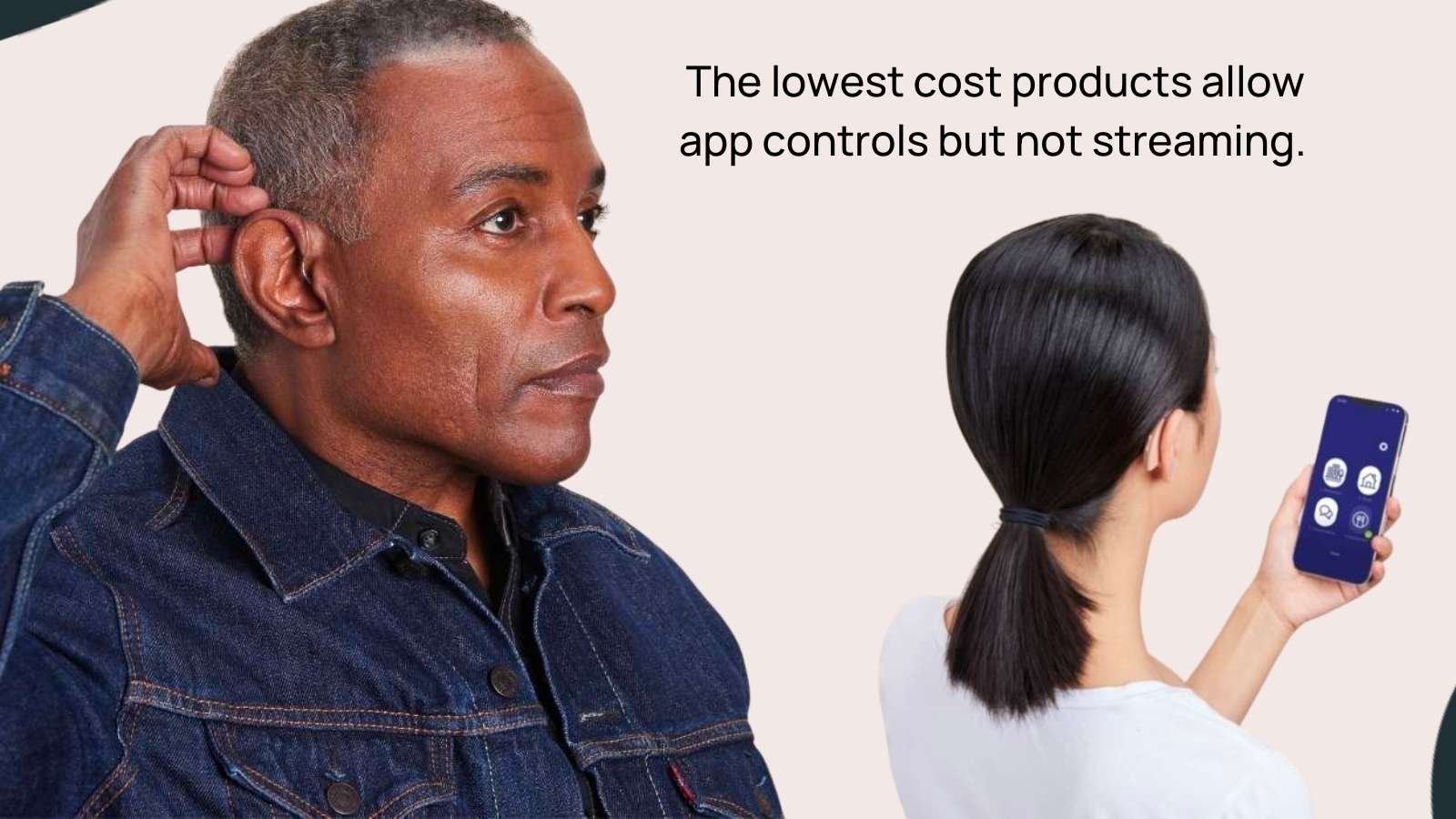
#2. Invisible-style hearing aids are less likely to include Bluetooth.
The smaller a device gets and the further it sits inside your ear, the harder it is to sustain a solid audio stream. Starkey currently has the smallest Bluetooth streaming hearing aid. This graphic shows the smallest Bluetooth device in their lineup.
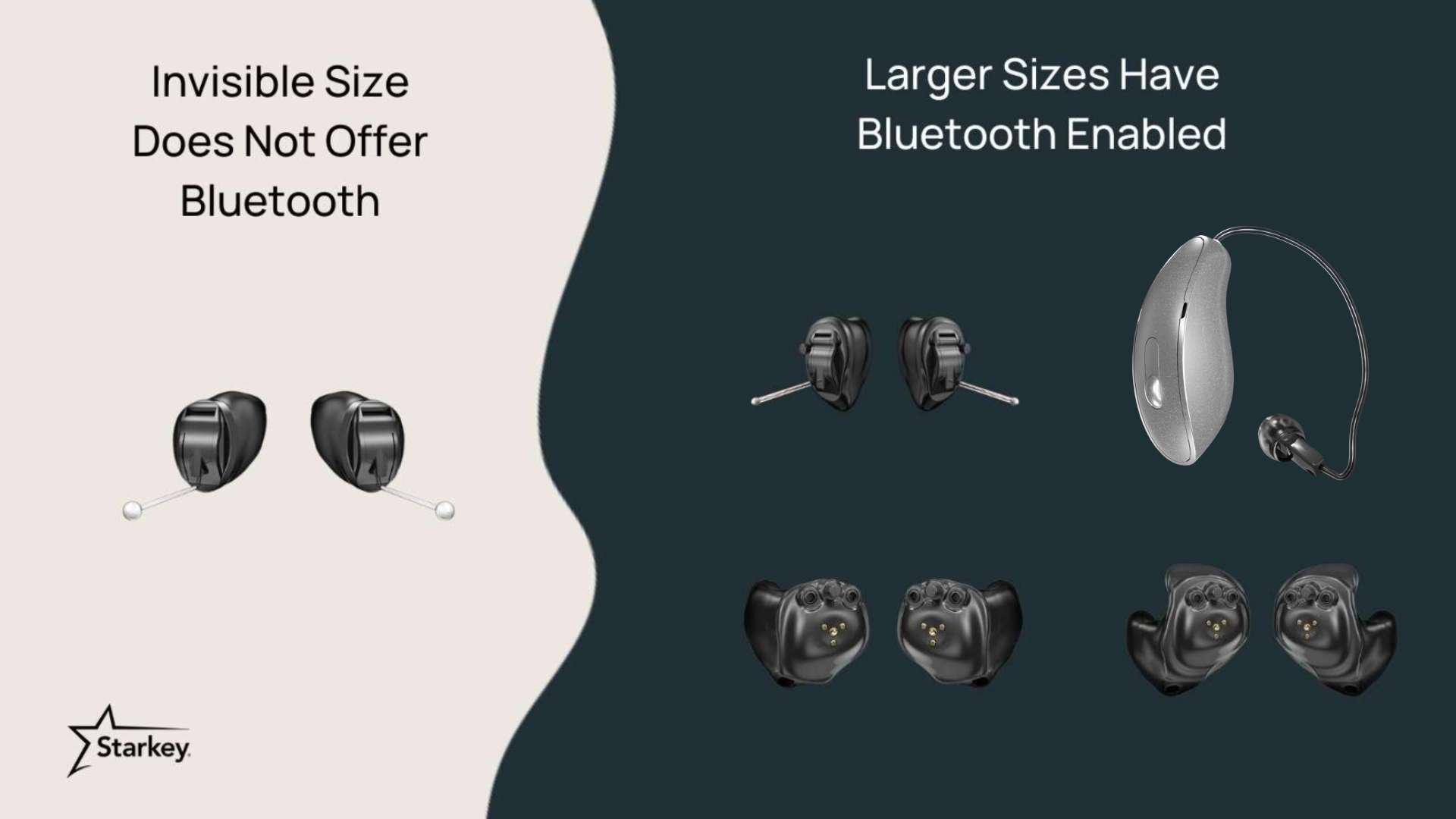
So let’s assume you’ve found a hearing aid that does have Bluetooth streaming. How do you know if that streaming capability is good?
What to Know About Bluetooth Low Energy and Auracast
Bluetooth Low Energy (BLE) and Auracast represent the next big leap in how hearing aids will connect to devices like phones, TVs, and even public systems. But what do these terms mean, and why should you care if you're in the market for hearing aids?
Bluetooth Low Energy (BLE) is a new version of Bluetooth that uses less power and provides a more stable connection than what we currently have.
If you’ve ever walked too far from your phone and heard crackling in your hearing aids, BLE will help fix that. It can maintain a stronger signal over longer distances—up to four times further without losing connection. This means better sound quality and more reliability in everyday use.
The big advantage of BLE is that it will simplify how hearing aids connect to other devices. Right now, iPhone users go through a system called MFI (Made for iPhone), and Android users have something called ASHA.
Both of these systems work, but they can be clunky and require extra steps to set up. With BLE, hearing aids will connect just like any other Bluetooth device—straight through the Bluetooth settings on your phone—making the process much easier, especially for new users.
While BLE is an exciting development, it’s important to note that it’s still rolling out. Over the next few years, more hearing aids and phones will start to support BLE, so if Bluetooth connectivity is important to you, it’s worth considering future-proofing by choosing a hearing aid that’s BLE-enabled today.
Auracast, on the other hand, is a feature that BLE unlocks. Think of Auracast like a "public broadcast" for audio. Imagine walking into a sports bar with several games on different TVs.
With Auracast, each TV could send an audio signal that you can pick up directly through your hearing aids, allowing you to listen to the game you care about without disturbing others. This technology could also be used in places like airports, churches, or theaters, where you can tap into a shared audio stream.
For hearing aid wearers, this means being able to connect to public audio systems in a way that’s personalized and seamless.
In short, Bluetooth Low Energy and Auracast are game-changers. They will make your hearing aids more powerful, easier to use, and able to connect to a world of new listening experiences.
While the full rollout will take a few years, investing in BLE-enabled hearing aids today will set you up for these exciting features in the future.
Here is a list of hearing aids that have BLE built-in today:
- ReSound NEXIA (built-in and turned on)
- Oticon Intent (built-in but requires a firmware update)
- Signia IX (built-in but requires a firmware update)
- Phonak Sphere and Phonak Infinio (built-in but requires a firmware update)
There are no major OTC hearing aids with BLE built-in at the time of this update. Sennheiser All Day Clear will likely age the best since it uses Bluetooth Classic which won't go anywhere for many years to come.
That's all for now, folks.
We hope you enjoyed this guide to the best Bluetooth hearing aids available. We update this page regularly and will be back with new models as they come.
We created this site to make finding hearing products and care more accessible.
To compare all the leading hearing aids, including the cost of Bluetooth hearing aids, head over to our shop tab. You can also check your hearing with our 5-minute hearing test.
If you have questions, you can email our team at any time [email protected].





